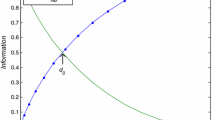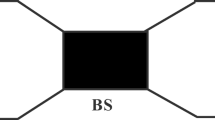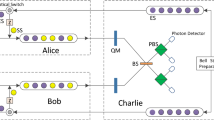Abstract
Quantum secure direct communication is the direct communication of secret messages without need for establishing a shared secret key first. In the existing schemes, quantum secure direct communication is possible only when both parties are quantum. In this paper, we construct a three-step semiquantum secure direct communication (SQSDC) protocol based on single photon sources in which the sender Alice is classical. In a semiquantum protocol, a person is termed classical if he (she) can measure, prepare and send quantum states only with the fixed orthogonal quantum basis {|0〉, |1〉}. The security of the proposed SQSDC protocol is guaranteed by the complete robustness of semiquantum key distribution protocols and the unconditional security of classical one-time pad encryption. Therefore, the proposed SQSDC protocol is also completely robust. Complete robustness indicates that nonzero information acquired by an eavesdropper Eve on the secret message implies the nonzero probability that the legitimate participants can find errors on the bits tested by this protocol. In the proposed protocol, we suggest a method to check Eves disturbing in the doves returning phase such that Alice does not need to announce publicly any position or their coded bits value after the photons transmission is completed. Moreover, the proposed SQSDC protocol can be implemented with the existing techniques. Compared with many quantum secure direct communication protocols, the proposed SQSDC protocol has two merits: firstly the sender only needs classical capabilities; secondly to check Eves disturbing after the transmission of quantum states, no additional classical information is needed.
Similar content being viewed by others
References
Shor P W. Algorithms for quantum computation: Discrete logarithms and factoring. In: Proceedings of the 35th Annual Symposium on Foundations of Computer Science. Santa Fe: IEEE Computer Society Press, 1994. 124–134
Bennett C H, Brassard G. Quantum cryptography: Public key distribution and coin tossing. In: Proceedings of International Conference on Computers, Systems and Signal Processing. Bangalore: IEEE, 1984. 175–179
Ekert A K. Quantum cryptography based on Bells theorem. Phys Rev Lett, 1991, 67: 661–663
Bennett C H. Quantum cryptography using any two nonorthogonal states. Phys Rev Lett, 1992, 68: 3121–3124
Lo H K, Chau H F. Unconditional security of quantum key distribution over arbitrarily long distances. Science, 1999, 283: 2050
Shor P W, Preskill J. Simple proof of security of the BB84 quantum key distribution protocol. Phys Rev Lett, 2000, 85: 441–444
Mayers D. Unconditional security in quantum cryptography. J Assn Comput Mach, 2001, 48: 351–406
Gisin N, Ribordy G, Tittel W, et al. Quantum cryptography. Rev Mod Phys, 2002, 74: 145–195
Deng F G, Long G L. Controlled order rearrangement encryption for quantum key distribution. Phys Rev A, 2003, 68: 042315
Hwang W Y. Quantum key distribution with high loss: Toward global secure communication. Phys Rev Lett, 2003, 91: 057901
Deng F G, Long G L. Bidirectional quantum key distribution protocol with practical faint laser pulses. Phys Rev A, 2004, 70: 012311
Wang X B. Beating the photon-number-splitting attack in practical quantum cryptography. Phys Rev Lett, 2005, 94: 230503
Lo H K, Ma X, Chen K. Decoy state quantum key distribution. Phys Rev Lett, 2005, 94: 230504
Li X H, Deng F G, Zhou H Y. Efficient quantum key distribution over a collective noise channel. Phys Rev Lett, 2008, 78: 022321
Boyer M, Kenigsberg D, Mor T. Quantum key distribution with classical Bob. Phys Rev Lett, 2007, 99: 140501
Tan Y G, Lu H, Cai Q Y. Comment on “Quantum key distribution with classical Bob”. Phys Rev Lett, 2009, 102: 098901
Boyer M, Kenigsberg D, Mor T. Boyer, Kenigsberg, and Mor Reply. Phys Rev Lett, 2009, 102: 098902
Boyer M, Gelles R, Kenigsberg D, et al. Semiquantum key distribution. Phys Rev A, 2009, 79: 032341
Lu H, Cai Q Y. Quantum key distribution with classical Alice. Int J Quantum Inf, 2008, 6: 1195–1202
Zou X, Qiu D, Li L, et al. Semiquantum-key distribution using less than four quantum states. Phys Rev A, 2009, 79: 052312
Boyer M, Mor T. Comment on “Semiquantum-key distribution using less than four quantum states”. Phys Rev A, 2011, 83: 046301
Zou X, Qiu D. Reply to “Comment on ‘Semiquantum-key distribution using less than four quantum states’”. Phys Rev A, 2011, 83: 046302
Miyadera T. Relation between information and disturbance in quantum key distribution protocol with classical Alice. arXiv:1105.2499, 2011
Boyer M, Mor T. On the robustness of (photonic) quantum key distribution with classical Alice. arXiv:1012.2418, 2010
Zhang X Z, Gong W G, Tan Y G, et al. Quantum key distribution series network protocol with M-classical Bobs. Chin Phys B, 2009, 18: 2143–2148
Wang J, Zhang S, Zhang Q, et al. Semiquantum key distribution using entangled states. Chin Phys Lett, 2011, 28: 100301
Li Q, Chan W H, Long D Y. Semiquantum secret sharing using entangled states. Phys Rev A, 2010, 82: 022303
Wang J, Zhang S, Zhang Q, et al. Semiquantum secret sharing using two-particle entangled state. Int J Quantum Inf, 2012, 10: 1250050
Long G L, Liu X S. Theoretically efficient high-capacity quantum-keydistribution scheme. Phys Rev A, 2002, 65: 032302
Boström K, Felbinger T. Deterministic secure direct communication using entanglement. Phys Rev Lett, 2002, 89: 187902
Wójcik A. Eavesdropping on the “ping-pong” quantum communication protocol. Phys Rev Lett, 2003, 90: 157901
Zhang Z, Man Z, Li Y. Improving Wójcik’s eavesdropping attack on the ping-pong protocol. Phys Lett A, 2004, 333: 46–50
Deng F G, Long G L, Liu X S. Two-step quantum direct communication protocol using the Einstein-Podolsky-Rosen pair block. Phys Rev A, 2003, 68: 042317
Gao T, Yan F L, Wang Z X. Quantum secure direct communication by EPR pairs and entanglement swapping. Nuovo Cimento Della Societa Italiana Di Fisica. B, Relativ Class Statist Phys, 2004, 119: 313–318
Deng F G, Long G L. Secure direct communication with a quantum one-time pad. Phys Rev A, 2004, 69: 052319
Man Z X, Zhang Z J, Li Y. Deterministic secure direct communication by using swapping quantum entanglement and local unitary operations. Chin Phys Lett, 2005, 22: 18
Gao T, Yan F, Wang Z. Quantum secure conditional direct communication via EPR pairs. Int J Mod Phys C, 2005, 16: 1293–1301
Wang C, Deng F G, Long G L. Multi-step quantum secure direct communication using multi-particle Green-Horne-Zeilinger state. Opt Commun, 2005, 253: 15–20
Wang C, Deng F G, Li Y S, et al. Quantum secure direct communication with high-dimension quantum superdense coding. Phys Rev A, 2005, 71: 44305
Wang C, Hao L, Song S Y, et al. Quantum direct communication based on quantum search algorithm. Int J Quantum Inf, 2010, 8: 443–450
Jin X R, Ji X, Zhang Y Q, et al. Three-party quantum secure direct communication based on GHZ states. Phys Lett A, 2006, 354: 67–70
Deng F G, Li X H, Li C Y, et al. Quantum secure direct communication network with Einstein-Podolsky-Rosen pairs. Phys Lett A, 2006, 359: 359–365
Li X H, Li C Y, Deng F G, et al. Quantum secure direct communication with quantum encryption based on pure entangled states. Chin Phys, 2007, 16: 2149
Wang T J, Li T, Du F F, et al. High-capacity quantum secure direct communication based on quantum hyperdense coding with hyperentanglement. Chin Phys Lett, 2011, 28: 040305
Gu B, Huang Y G, Fang X, et al. A two-step quantum secure direct communication protocol with hyperentanglement. Chin Phys B, 2011, 20: 100309
Gu B, Huang Y G, Fang X, et al. Bidirectional quantum secure direct communication network protocol with hyperentanglement. Commun Theor Phys, 2011, 56: 659
Gu B, Zhang C Y, Cheng G S, et al. Robust quantum secure direct communication with a quantum one-time pad over a collective-noise channel. Sci China Ser A, 2011, 54: 942–947
Shi J, Gong Y X, Xu P, et al. Quantum secure direct communication by using three-dimensional hyperentanglement. Commun Theor Phys, 2011, 56: 831
Gao G, Fang M, Yang R M. Quantum secure direct communication by swapping entanglements of 3 × 3-dimensional Bell states. Int J Theor Phys, 2011, 50: 882–887
Liu D, Chen J L, Jiang W. High-capacity quantum secure direct communication with single photons in both polarization and spatial-mode degrees of freedom. Int J Theor Phys, 2012, 51: 2923–2929
Sun Z W, Du R G, Long D Y. Quantum secure direct communication with two-photon four-qubit cluster states. Int J Theor Phys, 2012, 51: 1946–1952
Ren B C, Wei H R, Hua M, et al. Photonic spatial Bell-state analysis for robust quantum secure direct communication using quantum dot-cavity systems. Eur Phys J D, 2013, 67: 1–8
Cai Q Y. Eavesdropping on the two-way quantum communication protocols with invisible photons. Phys Lett A, 2006, 351: 23–25
Deng F G, Li X H, Zhou H Y, et al. Improving the security of multiparty quantum secret sharing against Trojan horse attack. Phys Rev A, 2005, 72: 044302
Li X H, Deng F G, Zhou H Y. Improving the security of secure direct communication based on the secret transmitting order of particles. Phys Rev A, 2006, 74: 054302
Zhu A D, Xia Y, Fan Q B, et al. Secure direct communication based on secret transmitting order of particles. Phys Rev A, 2006, 73: 022338
Long G, Deng F, Wang C, et al. Quantum secure direct communication and deterministic secure quantum communication. Front Phys China, 2007, 2: 251–272
Yan F, Zhang X. A scheme for secure direct communication using EPR pairs and teleportation. Eur Phys J B, 2004, 41: 75–78
Man Z X, Zhang Z J, Li Y. Quantum dialogue revisited. Chin Phys Lett, 2005, 22: 22
Gao T, Yan F L, Wang Z X. Deterministic secure direct communication using GHZ swapping quantum entanglement. J Phys-A-Math Gen, 2005, 38: 5761
Wang J, Zhang Q, Tang C. Quantum secure direct communication without using perfect quantum channel. Int J Mod Phys C, 2006, 17: 685–692
Wang J, Zhang Q, Tang C. Quantum secure direct communication without a pre-established secure quantum channel. Int J Quantum Inf, 2006, 4: 925–934
Li X H, Deng F G, Li C Y, et al. Deterministic secure quantum communication without maximally entangled states. J Korean Phys Soc, 2006, 49: 1354–1359
Wang H F, Zhang S, Yeon K H, et al. Quantum secure direct communication by using a GHZ state. J Korean Phys Soc, 2006, 49: 459–463
Schneier B. Applied Cryptography: Protocols, Algorithms, and Source Code in C. Manhattan: John Wiley & Sons, 1996
Brunel C, Lounis B, Tamarat P, et al. Triggered source of single photons based on controlled single molecule fluorescence. Phys Rev Lett, 1999, 83: 2722–2725
Michler P, Kiraz A, Becher C, et al. A quantum dot single-photon turnstile device. Science, 2000, 290: 2282–2285
Liu C, Dutton Z, Behroozi C H, et al. Observation of coherent optical information storage in an atomic medium using halted light pulses. Nature, 2001, 409: 490–493
Phillips D F, Fleischhauer A, Mair A, et al. Storage of light in atomic vapor. Phys Rev Lett, 2001, 86: 783–786
Kraus K, Böhm A, Dollard J D, et al. States, effects, and operations fundamental notions of quantum theory. Lect Note Phys, 1983, 190: 103–149
Steane A M. Simple quantum error-correcting codes. Phys Rev A, 1996, 54: 4741
Steane A M. Error correcting codes in quantum theory. Phys Rev Lett, 1996, 77: 793–797
Calderbank A R, Shor P W. Good quantum error-correcting codes exist. Phys Rev A, 1996, 54: 1098
Author information
Authors and Affiliations
Corresponding author
Rights and permissions
About this article
Cite this article
Zou, X., Qiu, D. Three-step semiquantum secure direct communication protocol. Sci. China Phys. Mech. Astron. 57, 1696–1702 (2014). https://doi.org/10.1007/s11433-014-5542-x
Received:
Accepted:
Published:
Issue Date:
DOI: https://doi.org/10.1007/s11433-014-5542-x




